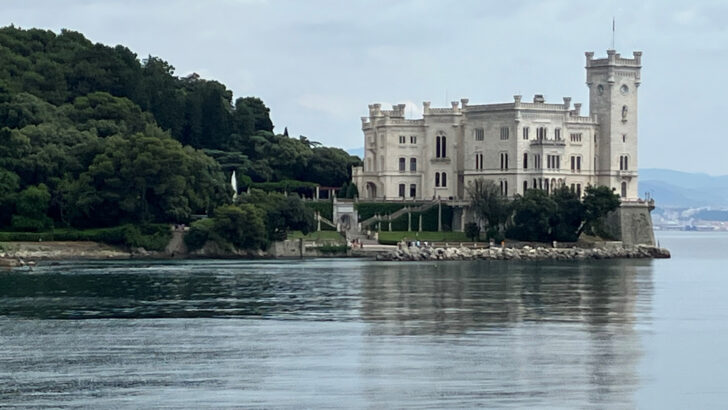Trieste Joyce School 2023
James Joyce lived in Trieste from 1905 to 1915, albeit with one interval of nine months spent in Rome in 1906-7. He moved to neutral Switzerland because of the First World War in 1915, but returned briefly to Trieste in 1919 before going to Paris where he would remain for almost the rest of his life.
He began writing Ulysses in Trieste in 1914, and it is generally acknowledged that that great novel was inspired as much by Trieste as it was by Dublin. It is truly a tale of two cities.
Joyce School
It is appropriate, therefore, that for the past 25 years Trieste has hosted a week-long Joyce School – attracting scholars, students and general readers of Joyce’s work. It was founded by John McCourt, a UCD graduate who has published widely on Joyce, particularly on Joyce’s period in Trieste.
He taught at the University of Trieste and at the University of Macerata, and is currently rector of the latter institution. He is still one of three organisers of the school, the others being Laura Pelaschiar (University of Trieste) and Richard Barlow (Nanyang Technological University).
This year the school ran from June 25-30 inclusive, with an opening ceremony on the evening of June 25 and three lectures on each of the following five mornings and seminars in the afternoons on Dubliners, Ulysses and Finnegans Wake. I was honoured to give one of the lectures.
I spoke about the Freeman’s Journal newspaper, in whose offices the Aeolus episode of Ulysses occurs. My purpose was to explain how much of that chapter is based on fact, though Joyce’s experience of the Freeman’s office relates not to 1904 – the year in which Ulysses is set – but rather to 1909 when, on a visit to Ireland from Trieste, he had occasion to call into the office and see at first hand “how a great daily organ is turned out” (to quote from Ulysses).
John McCourt, in his contribution to the School this year, spoke about another Triestine author, Italo Svevo, and his friendship with Joyce. It seems that Svevo, the son of a Jewish German father, was partly the model for Leopold Bloom.
Other lectures included one by Nicholas Allen, a native of Belfast now teaching in the University of Georgia (USA), on the importance of water and the sea in Joyce’s writings. He argued that the fact of Dublin and Trieste being port cities helped shape Joyce’s work.
Richard Barlow, Sam Slote (TCD) and Ronan Crowley (Aarhus University) considered aspects of Finnegans Wake. Barlow sought to locate the Wake in the context of the Irish Revival, concluding that it should be regarded as a post-Revival text. This chimed well with Crowley’s argument that the sources of data that Joyce used in composing the Wake were more cosmopolitan – less specifically Irish – than for his earlier writings.
A highlight of this year’s School was a presentation by five MA students at the University of Trieste on the subject of trees, plants and flora in Ulysses. They have been exploring this eco-theme – one that resonates strongly with our concerns about climate change – in a study group under the guidance of Laura Pelaschiar.
My visit to Trieste was not, of course, all work. I had ample time to explore that extraordinary city, part of the old Austro-Hungarian empire when Joyce first went to live there – as indeed it had been for the previous 500 years. Trieste was then one of the world’s great ports, the main gateway to the sea of the Austro-Hungarian empire.
Snatched
When that empire collapsed at the end of the First World War, the city was “snatched from its geography” (in the words of Jan Morris, author of Trieste and the Meaning of Nothingness) and ceded to Italy. Thereafter the port went into decline, having no obvious purpose within Italy. The character of the city today, and especially its architecture, retains much of its Habsburg heritage.
The scion of the Habsburg dynasty most associated with Trieste was Archduke Maximilian, younger brother of Emperor Franz Joseph I. He built the romantic castle of Miramar – in Italian, Miramare – on a promontory outside Trieste.
Sadly, he did not live to enjoy it. During the American Civil War, the French invaded Mexico with a view to re-establishing a European presence on the American continent. They installed Maximilian as the new Emperor of Mexico, but the venture failed miserably and Maximilian was executed by firing squad by the Mexicans – the subject of a famous painting by Édouard Manet.
There is an impressive statue of Maximilian in the Piazza Venezia in Trieste, near the Museo Revoltella where the Trieste Joyce School was held. Curiously, when Maximilian departed for Mexico in 1864, the Irish novelist Charles Lever was the British Consul in Trieste – and he died there in 1872. He is another link, in addition to Joyce, between Ireland and Trieste.


 Relic of an imperial past – Miramare Castle, built by Archduke Maximilian
Relic of an imperial past – Miramare Castle, built by Archduke Maximilian 